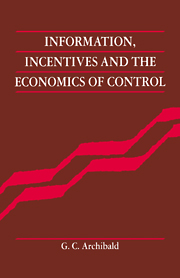Book contents
- Frontmatter
- Contents
- Preface
- Part I Introductory
- Part II Iterative controls
- 3 Feed-back control processes
- 4 First example: an externality problem
- 5 Second application of the control process: Lerner's Problem
- 6 Third example of the control process: implementation of a second-best solution
- 7 Two examples of the control process in a mixed economy
- Part III Non-convexities
- Part IV Cooperatives
- Appendix: The taxation of economic rent
- Notes
- Bibliography
- Index
4 - First example: an externality problem
Published online by Cambridge University Press: 19 October 2009
- Frontmatter
- Contents
- Preface
- Part I Introductory
- Part II Iterative controls
- 3 Feed-back control processes
- 4 First example: an externality problem
- 5 Second application of the control process: Lerner's Problem
- 6 Third example of the control process: implementation of a second-best solution
- 7 Two examples of the control process in a mixed economy
- Part III Non-convexities
- Part IV Cooperatives
- Appendix: The taxation of economic rent
- Notes
- Bibliography
- Index
Summary
Information requirements
In ch. 4, I describe the application of a real-time iterative control process to the control of a producer–producer externality. The example is very simple. It may, however, serve several purposes here. First, it provides an opportunity to display in some detail the mechanics of such a process, which may be unfamiliar to some readers. Second, it allows us to check the process against the list of necessary or desirable properties given in section 3.3 above. Third – and perhaps most important – it provides an opportunity to state and consider some necessary, and restrictive, technological assumptions. Consideration of strategic behavior is deferred to ch. 5. Ch. 4 concludes with some brief remarks on the relationship between the control problem studied here and the more general problem of Second Best.
It may be helpful to explain at the beginning who “we” are. “We” are government or some agency thereof, perhaps a Ministry of Production. We might even be the members of the Planning Commission for some industry or group of industries who have decided that the best way to discharge their office is to make it redundant. We are, in any event, in charge of designing the control process.
While methods of deriving optimal tax functions to control producer–producer externalities, at least in simple cases, are very well known, the computation of rates has remained a difficult problem.
- Type
- Chapter
- Information
- Information, Incentives and the Economics of Control , pp. 37 - 54Publisher: Cambridge University PressPrint publication year: 1992



